Blog & Latest Updates
Fly Fishing Articles
Insects by Common Name


Caddisfly Family Hydropsychidae
Taxonomic Navigation -?-
Kingdom
Animalia (Animals)
» Phylum
Arthropoda (Arthropods)
» Class
Insecta (Insects)
» Order
Trichoptera (Caddisflies)
» Family Hydropsychidae
5 genera aren't included.
This is page 3 of specimens of Hydropsychidae. Visit the main Hydropsychidae page for:
- The behavior and habitat of Hydropsychidae.
- 1 underwater picture of Hydropsychidae.
Pictures of 28 Caddisfly Specimens in the Family Hydropsychidae:
Male Cheumatopsyche (Little Sister Sedges) Caddisfly Adult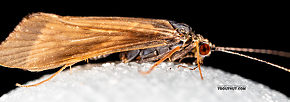 View 12 PicturesI didn't identify this one directly, but I eventually identified one of several I collected from the same swarms that appeared to be of the same species. (I lost track of which specimen was which in storage.) The microscope pictures come from one of these specimen, not necessarily the same specimen as the DSLR pictures. They key to Cheumatopsyche, and the hind wing venation (Venation: The pattern in which the veins on the wings of an insect are arranged. It is usually one of the most useful identifying characteristics.) that separates them from Hydropsyche is pretty clear in the attached picture as well as another specimen I checked under the scope.
View 12 PicturesI didn't identify this one directly, but I eventually identified one of several I collected from the same swarms that appeared to be of the same species. (I lost track of which specimen was which in storage.) The microscope pictures come from one of these specimen, not necessarily the same specimen as the DSLR pictures. They key to Cheumatopsyche, and the hind wing venation (Venation: The pattern in which the veins on the wings of an insect are arranged. It is usually one of the most useful identifying characteristics.) that separates them from Hydropsyche is pretty clear in the attached picture as well as another specimen I checked under the scope.
This specimen was one of tens of thousands we saw on a July 1st evening on the Madison, beginning with big swarms around every vehicle and tree at the Eight Mile Ford access point and continuing all up and down the river bank. We somehow didn't catch any trout, perhaps because they were stuffed with pupae from when these things emerged. Or maybe we just weren't fishing well. Either way, this one represents a major hatch there.
I somehow forgot to photograph this important specimen against the hooks size chart, but fortunately I preserved a few. The body length is about 6 mm, and total length from head to wingtip is 9 mm.
 View 12 PicturesI didn't identify this one directly, but I eventually identified one of several I collected from the same swarms that appeared to be of the same species. (I lost track of which specimen was which in storage.) The microscope pictures come from one of these specimen, not necessarily the same specimen as the DSLR pictures. They key to Cheumatopsyche, and the hind wing venation (Venation: The pattern in which the veins on the wings of an insect are arranged. It is usually one of the most useful identifying characteristics.) that separates them from Hydropsyche is pretty clear in the attached picture as well as another specimen I checked under the scope.
View 12 PicturesI didn't identify this one directly, but I eventually identified one of several I collected from the same swarms that appeared to be of the same species. (I lost track of which specimen was which in storage.) The microscope pictures come from one of these specimen, not necessarily the same specimen as the DSLR pictures. They key to Cheumatopsyche, and the hind wing venation (Venation: The pattern in which the veins on the wings of an insect are arranged. It is usually one of the most useful identifying characteristics.) that separates them from Hydropsyche is pretty clear in the attached picture as well as another specimen I checked under the scope. This specimen was one of tens of thousands we saw on a July 1st evening on the Madison, beginning with big swarms around every vehicle and tree at the Eight Mile Ford access point and continuing all up and down the river bank. We somehow didn't catch any trout, perhaps because they were stuffed with pupae from when these things emerged. Or maybe we just weren't fishing well. Either way, this one represents a major hatch there.
I somehow forgot to photograph this important specimen against the hooks size chart, but fortunately I preserved a few. The body length is about 6 mm, and total length from head to wingtip is 9 mm.
Collected July 1, 2019 from the Madison River in Montana
Added to Troutnut.com by Troutnut on July 18, 2019
Added to Troutnut.com by Troutnut on July 18, 2019
Male Hydropsyche occidentalis (Spotted Sedge) Caddisfly Adult View 6 PicturesDave Ruiter identified this specimen from pictures as Hydropsyche occidentalis.
View 6 PicturesDave Ruiter identified this specimen from pictures as Hydropsyche occidentalis.
 View 6 PicturesDave Ruiter identified this specimen from pictures as Hydropsyche occidentalis.
View 6 PicturesDave Ruiter identified this specimen from pictures as Hydropsyche occidentalis.Collected June 30, 2019 from the Madison River in Montana
Added to Troutnut.com by Troutnut on July 17, 2019
Added to Troutnut.com by Troutnut on July 17, 2019
Hydropsychidae Caddisfly Adult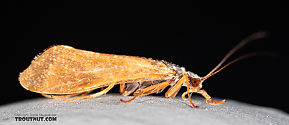 View 8 Pictures
View 8 Pictures
 View 8 Pictures
View 8 PicturesCollected July 8, 2019 from the Ruby River in Montana
Added to Troutnut.com by Troutnut on July 18, 2019
Added to Troutnut.com by Troutnut on July 18, 2019
Cheumatopsyche (Little Sister Sedges) Caddisfly Pupa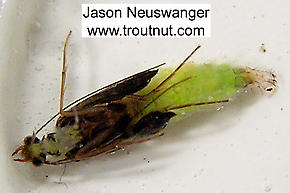 View 3 PicturesI was surprised how bright green this pupa is. It's chartreuse. After collecting it, I experimented with melting down chartreuse jigs and making little translucent rubber caddis abdomens on my flies. They looked good, and the trout liked them, but they weren't very durable at all. This specimen is recently deceased in the photographs.
View 3 PicturesI was surprised how bright green this pupa is. It's chartreuse. After collecting it, I experimented with melting down chartreuse jigs and making little translucent rubber caddis abdomens on my flies. They looked good, and the trout liked them, but they weren't very durable at all. This specimen is recently deceased in the photographs.
 View 3 PicturesI was surprised how bright green this pupa is. It's chartreuse. After collecting it, I experimented with melting down chartreuse jigs and making little translucent rubber caddis abdomens on my flies. They looked good, and the trout liked them, but they weren't very durable at all. This specimen is recently deceased in the photographs.
View 3 PicturesI was surprised how bright green this pupa is. It's chartreuse. After collecting it, I experimented with melting down chartreuse jigs and making little translucent rubber caddis abdomens on my flies. They looked good, and the trout liked them, but they weren't very durable at all. This specimen is recently deceased in the photographs.Collected May 18, 2004 from the Namekagon River in Wisconsin
Added to Troutnut.com by Troutnut on January 25, 2006
Added to Troutnut.com by Troutnut on January 25, 2006
Hydropsychidae Caddisfly Larva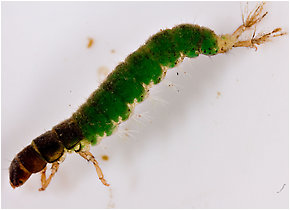 View 5 PicturesThis is one of the most vividly green Hydropsychidae larvae I've caught.
View 5 PicturesThis is one of the most vividly green Hydropsychidae larvae I've caught.
 View 5 PicturesThis is one of the most vividly green Hydropsychidae larvae I've caught.
View 5 PicturesThis is one of the most vividly green Hydropsychidae larvae I've caught.Collected May 6, 2007 from Mongaup Creek in New York
Added to Troutnut.com by Troutnut on May 18, 2007
Added to Troutnut.com by Troutnut on May 18, 2007
Hydropsychidae Caddisfly Larva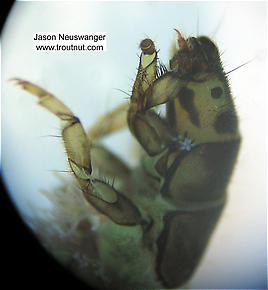 View 4 PicturesEvery picture of this Hydropsychidae larva was taken with my old C740UZ through a microscope.
View 4 PicturesEvery picture of this Hydropsychidae larva was taken with my old C740UZ through a microscope.
 View 4 PicturesEvery picture of this Hydropsychidae larva was taken with my old C740UZ through a microscope.
View 4 PicturesEvery picture of this Hydropsychidae larva was taken with my old C740UZ through a microscope.Collected November 15, 2004 from Fall Creek in New York
Added to Troutnut.com by Troutnut on April 12, 2006
Added to Troutnut.com by Troutnut on April 12, 2006
Female Hydropsyche (Spotted Sedges) Caddisfly Adult View 7 PicturesThis species was really common along the Henry's Fork at the end of July. I photographed it along with a male that appears to be the same species, and another male of the same genus but a seemingly different, less common (on this day) species.
View 7 PicturesThis species was really common along the Henry's Fork at the end of July. I photographed it along with a male that appears to be the same species, and another male of the same genus but a seemingly different, less common (on this day) species.
 View 7 PicturesThis species was really common along the Henry's Fork at the end of July. I photographed it along with a male that appears to be the same species, and another male of the same genus but a seemingly different, less common (on this day) species.
View 7 PicturesThis species was really common along the Henry's Fork at the end of July. I photographed it along with a male that appears to be the same species, and another male of the same genus but a seemingly different, less common (on this day) species.Collected July 31, 2020 from the Henry's Fork of the Snake River in Idaho
Added to Troutnut.com by Troutnut on August 17, 2020
Added to Troutnut.com by Troutnut on August 17, 2020
Female Cheumatopsyche (Little Sister Sedges) Caddisfly Adult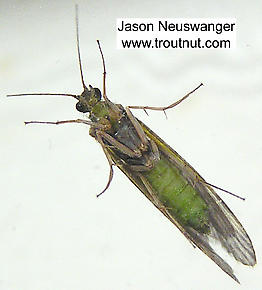 View 3 Pictures
View 3 Pictures
 View 3 Pictures
View 3 PicturesCollected May 16, 2004 from unknown in Wisconsin
Added to Troutnut.com by Troutnut on January 25, 2006
Added to Troutnut.com by Troutnut on January 25, 2006
Male Hydropsyche (Spotted Sedges) Caddisfly Adult View 8 Pictures
View 8 Pictures
 View 8 Pictures
View 8 PicturesCollected July 31, 2020 from the Henry's Fork of the Snake River in Idaho
Added to Troutnut.com by Troutnut on August 16, 2020
Added to Troutnut.com by Troutnut on August 16, 2020
Arctopsyche grandis (Great Gray Spotted Sedge) Caddisfly Larva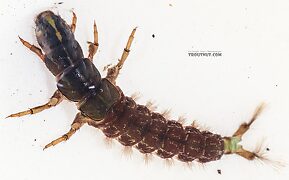 View 14 PicturesAt first I had trouble believing this giant Hydropsychidae larva was actually a member of its family, because of the size. I had never seen such a thing. It turned out to be a member of this exceptionally large species with a fitting name, grandis.
View 14 PicturesAt first I had trouble believing this giant Hydropsychidae larva was actually a member of its family, because of the size. I had never seen such a thing. It turned out to be a member of this exceptionally large species with a fitting name, grandis.
 View 14 PicturesAt first I had trouble believing this giant Hydropsychidae larva was actually a member of its family, because of the size. I had never seen such a thing. It turned out to be a member of this exceptionally large species with a fitting name, grandis.
View 14 PicturesAt first I had trouble believing this giant Hydropsychidae larva was actually a member of its family, because of the size. I had never seen such a thing. It turned out to be a member of this exceptionally large species with a fitting name, grandis.Collected August 3, 2020 from the East Fork Big Lost River in Idaho
Added to Troutnut.com by Troutnut on August 19, 2020
Added to Troutnut.com by Troutnut on August 19, 2020
Top 10 Fly Hatches
Top Gift Shop Designs
Eat mayflies.
Top Insect Specimens
Miscellaneous Sites
Troutnut.com is copyright © 2004-2024 Jason
Neuswanger (email Jason). See my FAQ for information about use of my images.
 privacy policy
privacy policy
